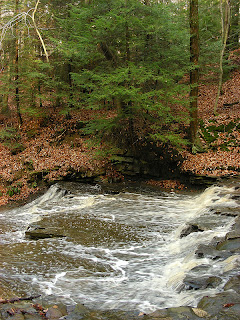On the brink, Bridal Veil Falls
Kali's mom (my mother-in-law) is developing dementia and can't live alone any longer. A year ago, after a plumbing accident in her house which simply overwhelmed Mom, Kali's brother flew to northeastern Ohio to gather-up Mom and a few of her things to take back to San Diego with him. She's been there ever since, and her house has sat empty.Because Mom can't move back to northeastern Ohio, we're getting ready to sell her house. Over the week preceding and including Thanksgiving, Kali, her brother, and I gathered in the house to get things organized and sort through a lifetime of possessions and memories. It was a physically and psychically challenging seven days we spent together.
On the last day we were together, we finished up our work in early afternoon and had a few hours before we had to take Kali's brother to the airport. I suggested a walk at my favorite natural area, Bridal Veil Falls on Deerlick Run in the Bedford Reservation of the Cleveland Metroparks system. Though it had rained in the morning, by late afternoon the wan autumn sun was shining.
I've posted images of the falls before. When I was growing up, the falls and the tight gorge below them were my favorite summer hangout. Back then, the Metroparks system had not yet built the elaborate boardwalk that now lets just about anyone who is ambulatory to view the falls. Decades ago, I entered the stream above the falls and waded, slid and scrambled all the way down to Deerlick Run's confluence with Tinker's Creek. A few hundred feet downstream of Bridal Veil Falls, Deerlick Run and another unnamed Tinker's Creek tributary each plunge over a shelf of resistant sandstone to create twin falls in an isolated hemlock-shaded glen, then course together with their waters conjoined. It was a sacred place for me.
Northern half of Twin Falls on an unnamed tributary of Tinker's Creek
Because Kali, her brother and I were content to just explore the falls' environs and not take a long hike, we got off the formal trail (which, incidentally, is part of the state-looping Buckeye Trail) and wandered through the woods along the lip of the gorge. To my utter disappointment, I found that my sacred place has been desecrated--not terribly, but enough to cause me great sadness. Many of the birches bore carvings in their bark, and a well-worn path traced the cliff edge. The woodland understory was virtually non-existent, and all of the very few saplings and root-sprouts had been nibbled by deer.
Fungus-encrusted snag in the woods
There's a very good chance that this will have been my last visit to Bridal Veil Falls. While my brother and his family and my sister and her family still live in northeastern Ohio, we are none of us particularly close and I have never returned to Ohio just to visit with my younger siblings. (Nor have they ever come to visit me in 23 years, either.)
Hemlocks and sycamore
And it's not just Bridal Veil Falls; this may have been my last bittersweet visit to Ohio, too, since we have professionals dealing with the sale of the house and the transaction can probably be completed by attorneys via mail or email. Though there are still tethers that can probably never be completely severed, I think it's time to move on.





















